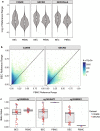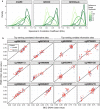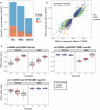Integration of DNA methylation patterns and genetic variation in human pediatric tissues help inform EWAS design and interpretation
- PMID: 30602389
- PMCID: PMC6314079
- DOI: 10.1186/s13072-018-0245-6
Integration of DNA methylation patterns and genetic variation in human pediatric tissues help inform EWAS design and interpretation
Abstract
Background: The widespread use of accessible peripheral tissues for epigenetic analyses has prompted increasing interest in the study of tissue-specific DNA methylation (DNAm) variation in human populations. To date, characterizations of inter-individual DNAm variability and DNAm concordance across tissues have been largely performed in adult tissues and therefore are limited in their relevance to DNAm profiles from pediatric samples. Given that DNAm patterns in early life undergo rapid changes and have been linked to a wide range of health outcomes and environmental exposures, direct investigations of tissue-specific DNAm variation in pediatric samples may help inform the design and interpretation of DNAm analyses from early life cohorts. In this study, we present a systematic comparison of genome-wide DNAm patterns between matched pediatric buccal epithelial cells (BECs) and peripheral blood mononuclear cells (PBMCs), two of the most widely used peripheral tissues in human epigenetic studies. Specifically, we assessed DNAm variability, cross-tissue DNAm concordance and genetic determinants of DNAm across two independent early life cohorts encompassing different ages.
Results: BECs had greater inter-individual DNAm variability compared to PBMCs and highly the variable CpGs are more likely to be positively correlated between the matched tissues compared to less variable CpGs. These sites were enriched for CpGs under genetic influence, suggesting that a substantial proportion of DNAm covariation between tissues can be attributed to genetic variation. Finally, we demonstrated the relevance of our findings to human epigenetic studies by categorizing CpGs from published DNAm association studies of pediatric BECs and peripheral blood.
Conclusions: Taken together, our results highlight a number of important considerations and practical implications in the design and interpretation of EWAS analyses performed in pediatric peripheral tissues.
Keywords: Buccal epithelial cells; DNA methylation; Genetic variation; Illumina 450K array; Pediatric; Peripheral blood leukocytes; Surrogate tissues.
Figures





Similar articles
-
Assessing the co-variability of DNA methylation across peripheral cells and tissues: Implications for the interpretation of findings in epigenetic epidemiology.PLoS Genet. 2021 Mar 19;17(3):e1009443. doi: 10.1371/journal.pgen.1009443. eCollection 2021 Mar. PLoS Genet. 2021. PMID: 33739972 Free PMC article.
-
Case-control meta-analysis of blood DNA methylation and autism spectrum disorder.Mol Autism. 2018 Jun 28;9:40. doi: 10.1186/s13229-018-0224-6. eCollection 2018. Mol Autism. 2018. PMID: 29988321 Free PMC article.
-
Systematic evaluation of DNA methylation age estimation with common preprocessing methods and the Infinium MethylationEPIC BeadChip array.Clin Epigenetics. 2018 Oct 16;10(1):123. doi: 10.1186/s13148-018-0556-2. Clin Epigenetics. 2018. PMID: 30326963 Free PMC article.
-
Epigenetics, Early Adversity and Child and Adolescent Mental Health.Psychopathology. 2018;51(2):71-75. doi: 10.1159/000486683. Epub 2018 Feb 23. Psychopathology. 2018. PMID: 29478063 Review.
-
Cell-type deconvolution in epigenome-wide association studies: a review and recommendations.Epigenomics. 2017 May;9(5):757-768. doi: 10.2217/epi-2016-0153. Epub 2017 Mar 14. Epigenomics. 2017. PMID: 28517979 Review.
Cited by
-
The Organ Trail: A Review of Biomarkers of Organ Failure.Front Oncol. 2020 Nov 11;10:579219. doi: 10.3389/fonc.2020.579219. eCollection 2020. Front Oncol. 2020. PMID: 33262945 Free PMC article. Review.
-
DNA methylation as a mediator of genetic and environmental influences on Parkinson's disease susceptibility: Impacts of alpha-Synuclein, physical activity, and pesticide exposure on the epigenome.Front Genet. 2022 Aug 19;13:971298. doi: 10.3389/fgene.2022.971298. eCollection 2022. Front Genet. 2022. PMID: 36061205 Free PMC article. Review.
-
Large epigenome-wide association study of childhood ADHD identifies peripheral DNA methylation associated with disease and polygenic risk burden.Transl Psychiatry. 2020 Jan 21;10(1):8. doi: 10.1038/s41398-020-0710-4. Transl Psychiatry. 2020. PMID: 32066674 Free PMC article.
-
Genome- and epigenome-wide association studies identify susceptibility of CpG sites and regions for metabolic syndrome in a Korean population.Clin Epigenetics. 2024 Apr 29;16(1):60. doi: 10.1186/s13148-024-01671-5. Clin Epigenetics. 2024. PMID: 38685121 Free PMC article.
-
From Mother to Child: Epigenetic Signatures of Hyperglycemia and Obesity during Pregnancy.Nutrients. 2024 Oct 16;16(20):3502. doi: 10.3390/nu16203502. Nutrients. 2024. PMID: 39458497 Free PMC article.
References
-
- Chadwick LH, Sawa A, Yang IV, Baccarelli A, Breakefield XO, Deng H-WW, et al. New insights and updated guidelines for epigenome-wide association studies. Neuroepigenetics. 2015;1C:14–19. doi: 10.1016/j.nepig.2014.10.004. - DOI
Publication types
MeSH terms
LinkOut - more resources
Full Text Sources
Molecular Biology Databases

